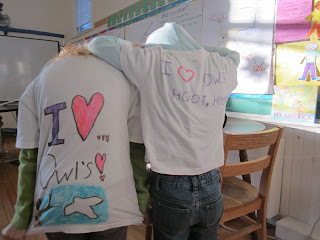No,
Chewonki is not a fictitious planet far, far away. It is a sanctuary and treatment center for injured wild animals, also an education center where people can learn about wildlife and the environment. Some of their educational programs travel, and that is how we were able to arrange for a visit from some very regal and wise looking live owls--all Maine residents. These owls have been injured, and they can no longer survive in the wild. So they live at Chewonki and travel to schools!
 |
| Screech owl (weighs less than a hershey bar!) |
 |
| Barred Owl (has black eyes!) |
You may ask: Why is every person at the Ashley Bryan School so fascinated with owls? Every day, before lunch, we snuggle up with pillows and sketch pads and are immersed in the fictitious owl world of "The Guardians of Ga'Hoole", by Katherine Lasky. We've been captivated by the story, and well, actually quite obsessed with owls since we've been reading it! Hence, the excitement had been mounting for weeks, as Friday, November 15 approached when
the owls are coming!
Our Friday visitors were accompanied by Emma Balazes, an amazing explainer of all things related to owls. Before she came, the students brainstormed questions about owls, that they hoped would be answered for them during Emma's presentation. Many questions came from owl behaviors they had learned about in the book. For example, "What is the correct term for when an owl 'yarps' a pellet"? (Answer: In real life, owls "cough up" pellets, also called "casting a pellet".)
As soon as she arrived, Emma set up a complete museum display in our classroom with lots of photos, samples of real owl feathers, wings, skulls, talons and more.
The largest owl Emma brought to show us was a Great Horned owl. Here are some facts we learned about this beautiful giant:
- Its “horned” feathers are not ears
- Its hooked beak acts as fork and knife to eat
- It's facial disc (mask) helps the owl hear better by directing sound with the feathers
- Its big eyes can see in the dark (nocturnal)
- It uses its sharp talons to catch prey
- It has barbed feathers (like a comb) that make its night flights absolutely silent
 |
| Great Horned Owl |
After the presentation, we had a chance to dissect real owl pellets! Emma told us that most owls will swallow prey whole, but if the prey is
too big, they’ll rip it up into big chunks. Owls can't digest bones and fur, so they cough up a pellet 8-18
hours after eating. Our job, as scientists, was to separate all the bones from the fur and other stuff in the pellet, examine the bones, and figure out what small animal that owl had eaten for its meal.
 |
| Definitely a rodent skull |
We were so sad to see the owls leave. Thank you Emma, and thank you Chewonki for your amazing work saving and teaching about these beautiful animals!













No comments:
Post a Comment